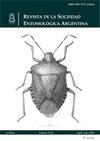阿尔及利亚6种蝗科(直翅目:蝗科:蝗科)的遗传和化学研究
IF 0.5
4区 农林科学
Q4 ENTOMOLOGY
引用次数: 0
摘要
Oedipodinae亚科是阿尔及利亚最丰富的种类和数量丰富的蝗科群。本文利用遗传和化学数据对6个物种进行了鉴定:毛利塔尼察俄狄波达(Oedipoda miniata mauritanica, Lucas, 1849);patruelis (Herrich-Shaeffer, 1838);A. insubricus insubricus (Scopoli, 1786);蓝藻(蓝布尔,1838);Sphingonotus (Neosphingonotus) finotianus(索绪尔,1885);和carinatus(索绪尔,1888)。在阿尔及利亚东北部ssametf地区的两个不同地点收集了个体。首先,根据标本的形态特征进行分类。其次,利用DNA条形码数据(COI基因)进行系统发育分析。第三,分析样品的角质层碳氢化合物(CHCs)。系统发育分析揭示了物种间的明显差异。化学分类分析表明,天蓝色沙棘和金翅沙棘的CHC谱相似,而黄叶沙棘和金翅沙棘的CHC谱存在差异。与azurescens和S. finotianus相比,S. carinatus含有碳链更短的正构烷烃和三甲基烷烃。这里获得的遗传和化学数据有助于澄清属内和属间的差异。这些数据也使我们能够清楚地区分六个物种。本文章由计算机程序翻译,如有差异,请以英文原文为准。
A genetic and chemical study of six Oedipodinae species (Orthoptera: Caelifera: Acrididae) from Algeria
The Oedipodinae subfamily is the most species-rich and numerically abundant group of Acrididae in Algeria. Here, genetic and chemical data were used to characterize the identities of six species: Oedipoda miniata mauritanica (Lucas, 1849); Acrotylus patruelis (Herrich-Shaeffer, 1838); A. insubricus insubricus (Scopoli, 1786); Sphingonotus (Neosphingonotus) azurescens (Rambur, 1838); Sphingonotus (Neosphingonotus) finotianus (Saussure, 1885); and Sphingoderus carinatus (Saussure, 1888). Individuals were collected from two different sites in the Sétif region of northeastern Algeria. First, specimens were classified based on their morphological traits. Second, phylogenetic analysis was performed using DNA barcoding data (COI gene). Third, the specimens’ cuticular hydrocarbons (CHCs) were analyzed. The phylogenetic analysis revealed clear distinctions among the species. The chemotaxonomic analysis highlighted CHC profile similarities between S. azurescens and S. finotianus and CHC profile differences between A. patruelis and A. i. insubricus. Compared to S. azurescens and S. finotianus, S. carinatus had n-alkanes and trimethylalkanes with much shorter carbon chains. The genetic and chemical data obtained here have helped clarify differences within and between genera. These data also enabled to clearly distinguish among the six species.
求助全文
通过发布文献求助,成功后即可免费获取论文全文。
去求助
来源期刊

Revista De La Sociedad Entomologica Argentina
Agricultural and Biological Sciences-Insect Science
CiteScore
0.80
自引率
20.00%
发文量
31
审稿时长
20 weeks
 求助内容:
求助内容: 应助结果提醒方式:
应助结果提醒方式:


